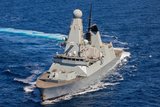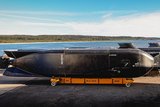New Zealand selects Sea Ceptor for ANZAC frigates
The New Zealand government has officially confirmed the selection of the MBDA Sea Ceptor for the Royal New Zealand Navy’s ANZAC Frigate Systems Upgrade (FSU) project, with the contract for the provision of the system signed on 21 May.
Sea Ceptor will equip the ANZAC frigates as the Local Area Air Defence element of the FSU project, bringing the vessels the ability to protect the host ship as well as combined joint allied forces in the vicinity.
Sea Ceptor is an active radar system that does not require the dedicated tracker/illuminator radars on which semi-active systems depend. Sea Ceptor deploys the Common Anti-air Modular Missile (CAMM) which, due to its soft launch technology, requires no efflux management system. This minimises the system’s mass and footprint thereby allowing for greater flexibility regarding ship installation positions.
Steve Wadey, managing director and group executive director technical, MBDA UK, said: ‘I am delighted that New Zealand has confirmed its selection of Sea Ceptor for the ANZAC FSU project. This first success in the global market outside the UK for Sea Ceptor is due not only to its advanced operational and through-life cost advantages, but also to the invaluable support provided by the UK government and the Royal Navy during discussions with the New Zealand Ministry of Defence.
‘Cooperation between the governments and the navies of the UK and New Zealand will continue to be important to delivering an excellent Sea Ceptor capability throughout the life of the project.’
More from Naval Warfare
-
![US Coast Guard prepares procurement of next-gen surface search radar]()
US Coast Guard prepares procurement of next-gen surface search radar
The NXSSR will replace five in-service capabilities and be the US Coast Guard’s primary collision avoidance system.
-
![MBDA-led DragonFire’s latest trials move the LDEW system closer to UK Navy integration]()
MBDA-led DragonFire’s latest trials move the LDEW system closer to UK Navy integration
The DragonFire lines up with other European laser-directed energy weapons being developed in collaboration with MBDA.
-
![US Coast Guard pursues solutions to increase maritime domain dominance]()
US Coast Guard pursues solutions to increase maritime domain dominance
The USCG is seeking technologies, services and applications to better connect its assets and speed up the decision-making process.
-
![Canadian Coast Guard’s OOSV delivery is “major milestone” in fleet modernisation]()
Canadian Coast Guard’s OOSV delivery is “major milestone” in fleet modernisation
The Polar Class 6 platform is the largest CCG science-dedicated vessel and will operate on the country’s east coast.
-
![How the Anduril-HHI autonomous ship plan fits in with the US Navy’s MASC programme]()
How the Anduril-HHI autonomous ship plan fits in with the US Navy’s MASC programme
The new modular vessel is expected to be developed for both commercial and defence use, with a heavy focus on production speed and mission flexibility.























